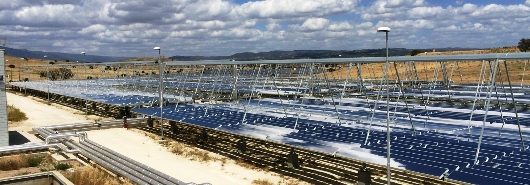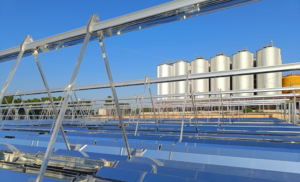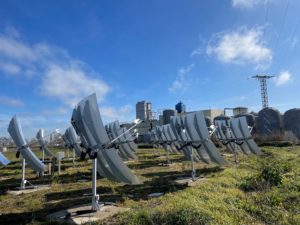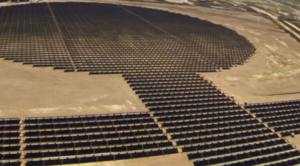

Italy: 10,000 m² ORC-Connected Fresnel and Parabolic Trough Fields
 Italy’s feed-in tariff for medium-size concentrating solar power plants has supported the installation of a 10,000 m² Fresnel collector array in Sardinia (see photo). The mirrors have been in operation since spring this year and are connected to an Organic Rankine Cycle (ORC) unit with 600 kW of nominal electric power. Construction for a second demonstration system, a 5 MWth parabolic trough field linked to an ORC turbine, is currently underway in Sicily. Both installations heat thermal oil to between 250 and 300 °C and use it to transfer heat directly from the solar panels to the ORC units by Italian-based Turboden, bringing their electrical efficiency to up to 25 %.
Italy’s feed-in tariff for medium-size concentrating solar power plants has supported the installation of a 10,000 m² Fresnel collector array in Sardinia (see photo). The mirrors have been in operation since spring this year and are connected to an Organic Rankine Cycle (ORC) unit with 600 kW of nominal electric power. Construction for a second demonstration system, a 5 MWth parabolic trough field linked to an ORC turbine, is currently underway in Sicily. Both installations heat thermal oil to between 250 and 300 °C and use it to transfer heat directly from the solar panels to the ORC units by Italian-based Turboden, bringing their electrical efficiency to up to 25 %.Photo: CSP-F (FERA Group)
Solar-powered ORC has been a niche application. Turboden has sold 352 ORC systems in 38 countries, but only three of them use solar energy, while another two are being set up right now. Together, their capacity added up to slightly more than 7 MWel, said Diego Albrigo, Sales and Business Development Manager at Turboden. In most cases, the ORC turbines ran on biomass. “Compared to other renewables for electricity production, such as photovoltaics and wind, concentrating solar power (CSP) output is easier to control, which makes ORC units based on this technology a heavy favourite for stand-alone systems, also in combination with other energy sources,” he added.
Turboden, a subsidiary of Mitsubishi Heavy Industries, is one of the largest ORC manufacturers in the world. The technology is suitable for distributed multi-source power generation, for example, based on renewables (biomass, geothermal and solar energy), industrial or incinerator waste heat, engines or gas turbines. It can be operated at lower temperatures and smaller capacities than water steam processes.
Fresnel and parabolic trough collectors to demonstrate viability
The first ORC-connected CSP system was inaugurated in spring 2017 in Sardinia’s Ottana municipality. Planned and installed by Italian-based CSP-F, a subsidiary of Fera Group, the Fresnel field is now operated by ENAS, the Sardinia Water Authority, and feeds power into the public grid. Beyond the GSE-funded electricity feed-in tariff, the plant and its concentrated PV unit have profited from a regional rebate. The system has additionally been equipped with two thermal-oil storage tanks. Their capacity is 14 MWth, which allows four operating hours at nominal load without solar radiation.
“These small systems could cost around EUR 5 million per MWel,” Albrigo said. “But the required investment will depend substantially on the number of ‘non-sunshine hours’ requested during plant operation, meaning the hours of autonomy that the system should have.” He said that the “trend in the short and medium term will be to focus on CSP plants between 3 and 5 MWel, as system smaller than this are often not economically viable.”
The second ORC-connected concentrating solar plant is currently being set up in the Melilli municipality, Sicily. Planned and installed by Archimede, an Italian-based engineering firm, it has just been sold to an investment group. The ORC unit receives heat through thermal oil from a 10,000 m² parabolic trough collector field and a small gas boiler. The storage will be smaller than for the system in Sardinia, guaranteeing just one hour of autonomy at full load. Thanks to the above-mentioned GSE feed-in tariff, electricity generation will net operators an incentive of about 341 EUR/MWh over 25 years.
National CSP electricity support programmes
GSE, which is short for Gestore dei Servizi Energetici, manages CSP funding with the help of a feed-in method which keeps the EUR/MWh tariff constant over 25 years. The tariff is paid for power from solar concentrating technologies, even if some of the heat for the turbine is produced by fossil fuels in hybrid mode.
The main technical requirement is a minimum value of nominal storage capacity. Plants having a mirror area of between 10,000 and 50,000 m² must provide 0.4 kWh of capacity per square metre; from 50,000 m², the factor is 1.5 kWh/m². Systems below or equal to 10,000 m² are not required to provide a certain capacity level.
| Power (kW) | 25-year feed-in tariff (EUR/MWh) |
| 1 to 250 | 324 |
| 250 to 5,000 | 296 |
| > 5,000 | 291 |
Feed-in tariff base amounts for CSP plants, as per Ministerial Decree 23 June 2016
The tariff also depends on plant size and an ‘integration factor’ calculated based on Fint = 1 – Ps/Pne, where Ps is the net electricity produced by the solar resource and Pne the plant total. The base tariff can be increased by 20 EUR/MWh if Fint is 0.15 to 0.5 and by 45 EUR/MWh if the same value is lower than or equal to 0.15. The above mentioned feed-in tariff of 341 EUR/MWh includes the base amount for a 1 MW plant of 296 EUR/MWh together with an additional value of 45 EUR/MWh because of the high storage volume.
Websites of organisations mentioned in this article:
Turboden: http://www.turboden.com
CSP incentive scheme: http://www.gse.it/Appoggio/Solare%20termodinamico/Pages/default.aspx
CSP-F: http://www.cspfsolar.it/


